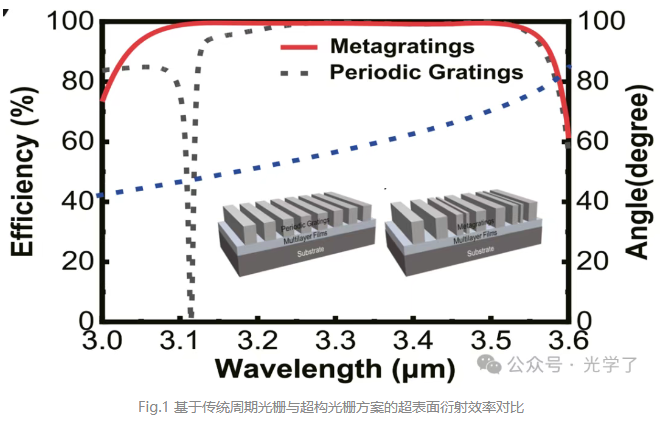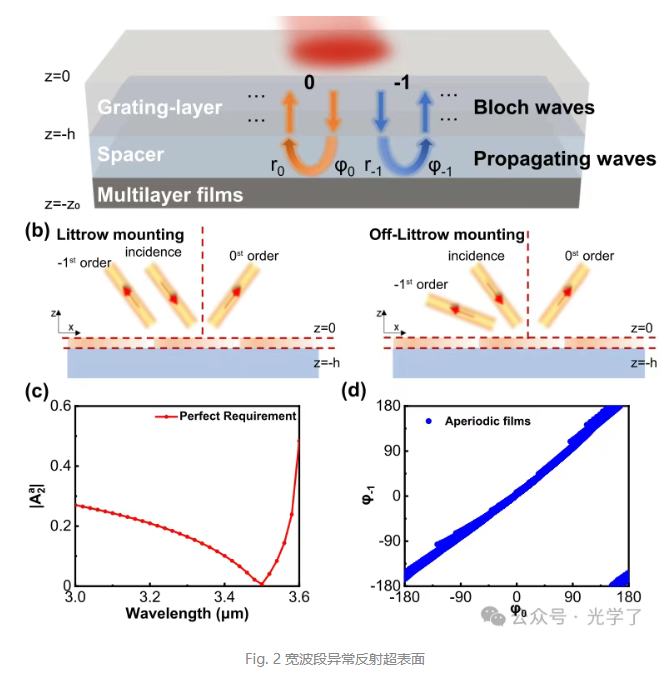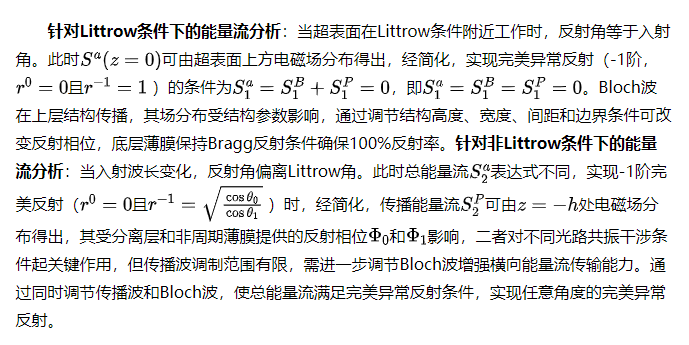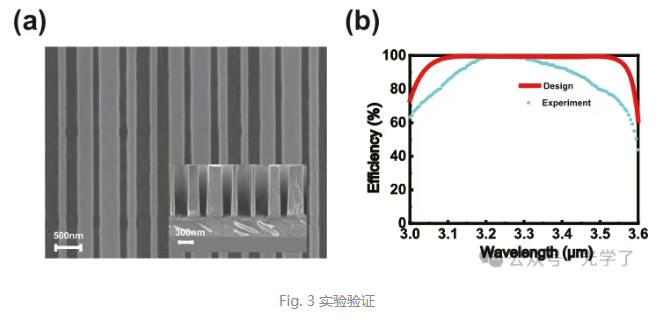Chongfan Technology
News
22
2025
-
05
Broadband Perfect Littrow Diffraction Metasurface under Large Angle Incidence
Author:
In the field of laser technology, Littrow diffraction devices are widely used in laser resonators and spectrometer equipment due to their high efficiency. However, traditional diffraction devices often struggle to achieve broadband, high-efficiency diffraction under large-angle incidence, which limits their application in highly integrated and complex functional optical systems. Recently, a research article published in Nanophotonics [1] proposed a novel metasurface structure that successfully achieved broadband perfect Littrow diffraction under large-angle incidence, offering new insights for solving the aforementioned challenges.

The article proposes a Littrow diffraction metasurface composed of a metagrating and non-periodic multilayer films, which addresses the energy flow mismatch problem during large-angle incidence through non-local response. It elaborates on metasurface theory, analyzes energy flow distribution under Littrow and non-Littrow conditions, and discusses conditions for perfect anomalous reflection. A broadband reflector based on a metagrating was designed. The results show that the metagrating can enhance control over Bloch waves. After PSO optimization, broadband perfect anomalous reflection with 99% efficiency was achieved from 3.11μm to 3.52μm. Due to its strong non-local effect, the bandwidth increased by 46% compared to reflectors based on periodic gratings.
Based on the Huygens-Fresnel principle, the article indirectly influences reflection by controlling the field distribution above the metasurface (energy flow distribution and Poynting vector). Incident light excites Bloch waves within the grating, and both propagating waves and evanescent waves exist in the separation layer. The system's transverse energy flow transfer primarily relies on multiple scattering at the interface between the separation layer and the grating, with evanescent waves being ignored in the research process.


Through the above analysis, the researchers, during the design process, first fixed the multilayer film thickness, scanned the structural linewidth and height, and found parameters that matched the target energy flow as an initial solution. Then, the Particle Swarm Optimization (PSO) algorithm was used to optimize the non-periodic film thickness and structural linewidth. The multilayer film primarily affects the propagating wave energy flow, while the upper structure controls the Bloch wave energy flow . Under Littrow conditions, the propagating wave energy flow is zero, mainly to prevent the Bloch wave from generating non-local effects; when deviating from Littrow conditions, the propagating wave energy flow increases but with limited control ability, and the Bloch wave still plays a decisive role, requiring enhanced non-local effects to meet the perfect diffraction requirements.

This research successfully designed a non-local metasurface, achieving broadband perfect Littrow diffraction under 70° incidence, offering advantages over existing research in terms of incidence angle, bandwidth, and efficiency. Through this novel metasurface structure, the research team not only broke through the bandwidth limitations of traditional diffraction devices under large-angle incidence but also provided new possibilities for the design of future optical systems. This metasurface structure has broad prospects in practical applications and is expected to promote the development of related technologies.
LATEST NEWS
2025-06-06
Photonic avalanche nanocrystals with >500-order optical nonlinear response
At the forefront of nonlinear optical materials research, photon avalanche (PA), a unique luminescence mechanism occurring in lanthanide-ion-doped systems, exhibits exponential response under continuous laser pumping through an energy positive feedback loop mechanism, thus demonstrating ultra-high-order nonlinear optical behavior far exceeding traditional upconversion processes.
2025-06-05
Ji Xingchen/Su Yikai LPR | 780 nm on-chip integrated high-Q ultra-wideband Fabry-Perot cavity
With the rapid development of applications such as quantum precision measurement, atom manipulation, and narrow linewidth lasers, higher and higher demands are placed on high-performance photonic devices operating in the visible and near-visible wavelength range (especially the 780 nm wavelength corresponding to the rubidium atomic transition).
2025-06-23
Binary optics and metasurface lenses
Bichromatic optics is a subject or an optical technology; the concept of a meta-lens is more inclined to be a device.
2025-06-23
Achromatic diffractive waveguide in AR glasses
AR glasses seem to have developed rapidly in recent years; many believe this is the device most likely to replace mobile phones in the future.
Thank you for visiting the official website of Chongfan Technology. If you have cooperation intentions or suggestions, please contact us through the following methods, and we will reply as soon as possible, thank you!
Address: Room 403, Building 6, Phase III of R&D, No. 36 Xiyong Avenue, High tech Zone, Chongqing, China.
Telephone: +86-13658337211
E-mail: Sales@cfkeji.net
Website: www.cfkeji.net
Mobile Version

